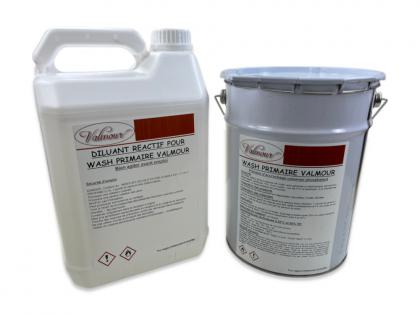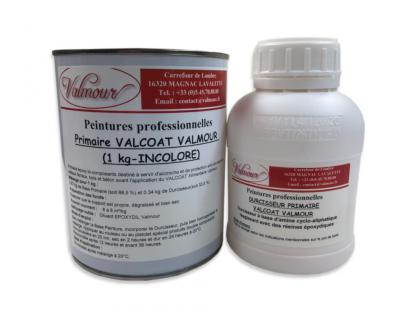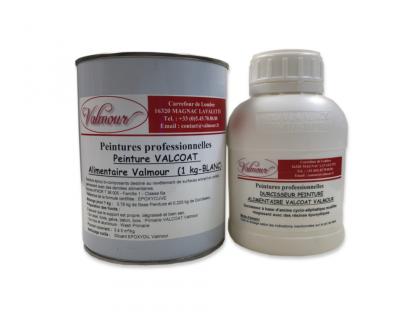Valmour proposes 2 types of food-compatible paint:
- VALCOAT Food Compatible Paint which is certified for "permanent contact" with food, for example for water on wine tanks , for interior and exterior use.
- VALMA Food Environment Paint, which is suitable for food environments like the partitions of displays, but only for interior use.
Depending on the type of surface you want to protect, you need to proceed in different steps. To work on a perfectly clean, grease-free and dry surface, follow the recommendations below:
A - PERMANENT CONTACT :
On Steel and Cast Iron, Galvanized Steel :
1 - If the metal is rusty, brush carefully with the Steel Brass Brush Louis XIII and the Oval Horsehair Brush below to eliminate any loose rust, then apply Stop Rust Converter, which will increase the anti-rust protection in time. Leave to act for 48 hours and dust off.
You can also sandblast the metal. Afterwards, it is more fragile and needs to be covered within 24 hours.
Use Glasspaper 180 (very fine) on any already painted surfaces you conserve to take off the shine.
To finish, eliminate any grease with acetone or with DILUVAL.
2- Prepare the surface by applying a coat of VALCOAT Primer. This anti-corrosion product for iron-containing metal prepares the surface for the treatment with VALCOAT Food Compatible Paint as finish, but is not a food-compatible paint itself. Observe an 8 hour waiting period.
3- As a finish, apply Valmour VALCOAT Food Compatible Paint. This bi-component epoxy coating for permanent food contact is applied in one single coat with a Paint Brush or a Roller.
4- Afterwards, let dry for 21 days before washing with hot water. This waiting period is necessary to certify the absence of component migration.
On Stainless Steel and Aluminium :
If you're in doubt concerning the type of metal you're intending to paint, test it with a magnet: aluminium will not be attracted.
1- If the aluminium is rusty, start by brushing it carefylly with the help of a Steel Brass Brush Louis XIII and the Oval Horsehair Brush below. Do not sandblast or apply anti-rust products.
.On already painted surfaces you want to conserve, take off the shine by sanding them with Glasspaper 180 (very fine). Finish by degreasing with acetone or DILUVAL.
2- Prepare the surface by applying a coat of WASH PRIMER VALMOUR, to ensure perfect hold of the finishing paint. This primer is delivered with its reactive thinner, to be mixed one hour before the application. This base coat is not food- compatible. After application, leave for 8 hours.
Another solution to prepare the stainless steel or aluminum surface is to clean the surface to be painted with a mixture of water and 10% phosphoric acid.
3- To finish, apply Valmour VALCOAT Food Compatible Paint, which is a bi-component epoxy coating for permanent food contact, in a single coat, with a Paint Brush or a Roller.
4- Afterwards, let dry for 21 days before washing with hot water. This waiting period is necessary to certify the absence of component migration.
On Concrete :
1-To begin with, make sure that the concrete is in good condition. Remove any non-adherent coatings by sanding or sand blasting. Dust thoroughly and, if necessary, reapply a coat of concrete to obtain a perfectly smooth surface. If necessary, eliminate any concrete laitance with the help of Acid Based Remover Louis XIII. On already painted surfaces you want to keep, sans with Glass paper 180 (very fine) to eliminate the shine.
2- Prepare the surface by applying a coat of Valmour VALCOAT Primer, to ensure perfect hold of the finishing paint. This base coat is not food- compatible. After application, leave for 8 hours, or until the material has dried in-depth.
3- To finish, apply Valmour VALCOAT Food Compatible Paint, which is a bi-component epoxy coating for permanent food contact, in a single coat, with a Paint Brush or a Roller.
4- Afterwards, let dry for 21 days before washing with hot water. This waiting period is necessary to certify the absence of component migration.
On Wood, Particle board, MDF and Plasterboard :
1- Brush thoroughly with the Bronze Brush and the Oval Brush below to remove any non-adherent paint or coating.
2- Prepare the surface by applying a coat of VALCOAT Primer Valmour. This product prepares the surface for the treatment with and better hold of VALCOAT Food Compatible Paint as finish, but is not food-compatible itself. Observe an 8 hour waiting period.
3- As a finish, apply Valmour VALCOAT Food Compatible Paint. This bi-component epoxy coating for permanent food contact is applied in one single coat with a Paint Brush or a Roller.
4- Afterwards, let dry for 21 days before washing with hot water. This waiting period is necessary to certify the absence of component migration.
On Plastic :
1- Clean thoroughly to obtain a completely dirt-and grease-free surface.
2- To increase the hold of the finishing paint and to clean, apply the following mixture: 90% water and 10% hydrochloric acid. Spray onto the surface, leave to work and rince with DILUVAL Thinner Valmour below. This action can be replaced by sanding or sand-blasting
3- To finish, apply Valmour VALCOAT Food Compatible Paint, which is a bi-component epoxy coating for permanent food contact, in a single coat, with a Paint Brush or a Roller.
4- Afterwards, let dry for 21 days before washing with hot water. This waiting period is necessary to certify the absence of component migration.
On Extruded Polystyrene, Fiberglass, Polyester, Copper and Copper alloys :
No need to apply a primer, you can directly apply Valmour Food Compatible Paint.
- Fiberglass: clean thoroughly before, for example with a hot water high pressure cleaner.
- Fiberglass covered by epoxy resin: apply Food Compatible Paint VALCOAT within 20 hours. If the delay after applying the epoxy resin is longer, it is essential to sand the resin with coarse-grained sandpaper first for a better hold of the paint.
- On copper and copper alloys, it is absolutely necessary to eliminate any trace of oxydation before applying Valmour VALCOAT Food Compatible Paint. Use our Deoxidizer Copper Brass Bronze Louis XIII.
Remarks :
In all cases, VALCOAT Food Compatible Paint VALMOUR can be applied to all types of already existing paint, because it is solvent-free.
- On fragile non-metal surfaces like wood, particleboard, mdf and plasterboard, allow a thickness of at least 1 mm of paint, to prevent its deterioration through retraction during cross-linking of the polymer chains.
B - FOOD ENVIRONMENT :
On Wood, Stone, Walls, Metal, Tiles :
1- Brush thoroughly with the Oval Brush below to eliminate any loose paint or coating
- Brush and rinse already existing coats of paint to to eliminate loose parts.
- On iron- containing metals, aluminium, concrete, natural stone or smooth surfaces like PVC, make sure to eliminate any traces of grease, for example with Cleaner Grease Remover Louis XIII (avoid acetone which can leave odors).
2- Apply Smooth Surface Primer Valmour (temperature for application 15 °C.)
3- Afterwards, wait for 24 hours, then apply VALMA Food Environment Paint or FRIGOVAL Food Environment Paint.
On Concrete Floors :
Prefer Valmour VALCOAT Food Compatible Paint, which is more resistant (see above).
Tel. : +33 (0)5 45 70 80 80
For any professional use of this advice card, please contact us.

VALMOUR WASH PRIMER
Undercoat permitting the application of paint on light alloy and non-ferrous metal: aluminium, galvanised metal, stainless steel... Surfaces must be clean, degreased, derusted, rinsed and dried.Supplied with a Reactive ...
Details
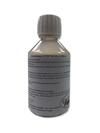
STOP RUST Converter Valmour
Maintenance product for steel and rust. Stops the rust and transforms it into a protective and very decorative deep blue-black coat, which accepts all finishes without primer.STOP RUST Converter ...
Details

VALMOUR VALCOAT Primer
Anticorrosion epoxy bi-component primer for treating metal sufaces (apart from light alloys), concrete or wooden surfaces before applying VALCOAT Food Paint. ...
Details

VALCOAT Food Compatible Paint VALMOUR
Coating for all materials in permanent contact with foodstuff, from - 20°C to 100 °C: wine or water tanks, wine press, food truck, earthenware or cast-iron fondue dish etc.VALCOAT ...
Details
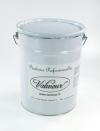
VALMA Food Environment Paint
Aqueous emulsion paint for food environment suitable for premises, displays... in the presence of food without permanent contact.VALMA paint is ready to use, anti- fungi and anti-bacterial, and very ...
Details
